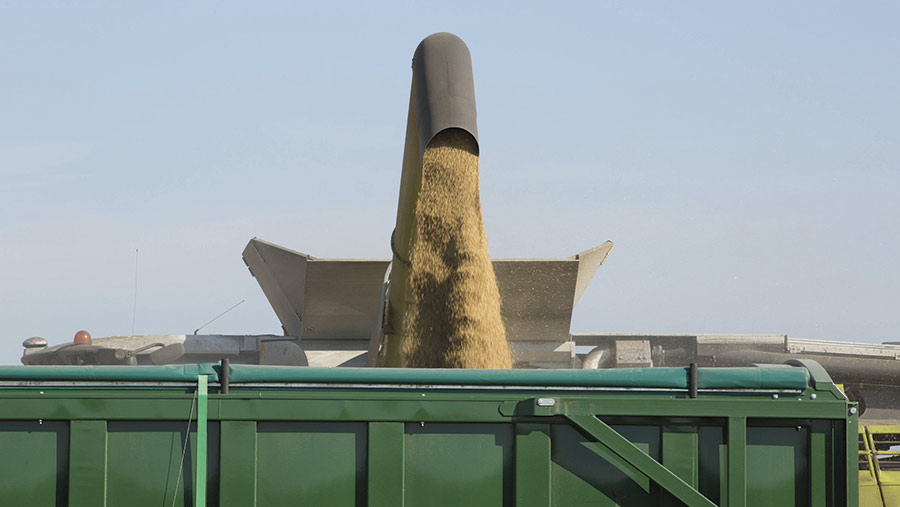Crop Watch: Combines close in on winter cropping
 © Tim Scrivener
© Tim Scrivener It’s the final Crop Watch of this season and our agronomists are sharing what they have learned this season, with Ryan Hudson pondering whether wider tramline widths would help with crop ripening.
Tod Hunniset shares a review of the season from a southern perspective, saying it’s been a season of extremes since Christmas.
Lack of moisture is unlikely to be a limiting factor at this stage of the year, says David Martindale, but we still need plenty of sunlight.
See also: How to tackle herbicide resistance in broad-leaved weeds
Neil Potts points to a rise in the incidence of brome, warning that the weed is spreading to farms where it previously hadn’t been seen.
South: Tod Hunnisett
AICC (Sussex)
 What a funny old year it has been. While 2016 was described as the year of the aphid, 2017 could be described as the year of extremes.
What a funny old year it has been. While 2016 was described as the year of the aphid, 2017 could be described as the year of extremes.
For the first time in about five years, we actually had an autumn that allowed us to get everything done.
In fact, it was dry enough to prevent us getting a chit of wheat in winter barley, and some of the earlier residual herbicides didn’t work as well as they should have.
But slugs and aphids were nothing like as problematic as they have been in previous years, and the continuing kind conditions allowed us to get follow-up herbicides on in good time and conditions.
Then the extremes started. After a dry autumn, we had a very wet late winter/early spring. Enough to scupper any thoughts of any operations on heavy land.
Because of the mild Christmas, crops took off early and it looked like growth regulator supplies would run out.
Then it stopped raining. For a long time. Wet ground that couldn’t be travelled on finally got some nitrogen, but by then it had dried out to a point that the nitrogen couldn’t be taken up by the plant.
Temperature swings
On 9 April the temperature went up to 24C in the shade at home (north Hampshire). On 27 April it went down to -6C overnight in mid-Hampshire.
Finally the rain came. April-drilled spring wheat emerged in June and the wheat recovered, along with the grassweeds.
All looked fine and dandy until late June, when the temperatures went up to more than 30C – the oilseed rape packed up and brown rust exploded. Waiting on what looks to be an early harvest, I do wonder what’s coming next.
East: Ryan Hudson
Farmacy (Bedfordshire/Hertfordshire)
 As we head into an early harvest, the main issue in the winter barley – as is often the case in cereal crops – is green in the tramlines.
As we head into an early harvest, the main issue in the winter barley – as is often the case in cereal crops – is green in the tramlines.
One thing to consider is if enough rows are blanked off when putting tramlines in on the drill to allow the sprayer tyres along the tramlines without rolling down crop.
If we are looking to improve glyphosate stewardship, this is something that can help even up senescence without desiccation.
As the rapeseed harvest gets under way, stubbles should be inspected to establish actual plant populations, but also for signs of disease and areas of blackgrass.
This will allow us to further map the problem areas and prioritise fields for autumn drilling, as very often the blackgrass germinates late under the canopy, going unnoticed until the following wheat has been planted.
Obviously the weather and soil conditions will dictate drilling, but we have again seen the issues with drilling in September on blackgrass land due to the fear that we will not get the crop in if it rains.
Residual warning
There should also be a word of caution that residual herbicides worked fantastically well in autumn 2016 and this saved many who drilled early.
This will not be the same each year and just because we got away with it one year doesn’t mean we will the next.
Variety choice this year seems to be vast, with so many new varieties, but many wheats can be removed based on low genetic disease resistance, standing ability and grain quality.
Getting the right variety is important, but as much – if not more – time should be spent considering cultivation and drilling methods, as this will ensure the variety performs to its potential and will have a greater bearing on final yield.
North: David Martindale
Arable Alliance (Yorkshire)

David Martindale
More heavy rain and strong winds last week was unwelcome. The combination of wind and rain has ruffled several crops, with spring barley the most affected.
Thankfully any lodging has generally occurred on the headlands on fertiliser overlaps. Overall crop yield potential looks promising, providing there is now plenty of sunshine in the coming weeks. Shortage of moisture is unlikely to become a limiting factor now.
Peas and beans are the only combinable crops requiring fungicide input. Spring beans are now at the end of flowering and final fungicides are being applied to protect against bean rust and chocolate spot.
Black bean aphids had rapidly colonised plants and built up to high levels quickly, with insecticides recently applied for their control appearing to have worked well.
In combining and vining peas, foot-rots have appeared where there was high rainfall in early June. Where unaffected by this, the peas look particularly well and are receiving their final fungicide.
Rapeseed ripening
Oilseed rape crops are now being desiccated or swathed. With crops very even this year, there are opportunities to let crops ripen naturally and not bother with desiccation.
However, if adopted, nerves of steel and bags of patience are required to wait for the crops to ripen under their own steam.
Winter wheat crops generally look well. Some fusarium ear blight is showing on most crops now, with susceptible varieties such as Grafton showing higher levels.
There are plenty of new wheat varieties to choose from and many are showing improved septoria resistance, which is great news.
However, many of these new varieties have weaker straw and sometimes do not have orange blossom midge resistance. So it is a case of weighing up the different risks, with no new wonder variety leaping out from the AHDB Recommended List.
Good luck for harvest and I hope it goes well with good yields and quality.
West: Neil Potts
Matford Arable (Devon)
 With the cereal agronomy season all over bar the shouting, we enter July, which is the month that tends to show up all the successes and failures of the various strategies adopted across the season.
With the cereal agronomy season all over bar the shouting, we enter July, which is the month that tends to show up all the successes and failures of the various strategies adopted across the season.
Early indications would indicate brome infestations are on the increase and are finding their way on to farms not previously infested.
The spread of this group of grassweeds is in part down to poor combine hygiene. Being awned, the seeds tend to hang up in the sieves and shake out as the combine moves to fresh fields.
Home-saved seed is also playing a part, as some species of brome have quite large seeds that remain in the grain sample even after cleaning.
People like to blame min-till or non-inversion tillage for the rise of brome infestations, but it is cropping up on farms where the plough has been exclusively used as well.
I believe another contributory factor is the return into the cropped area of many field margins that have come out of Countryside Stewardship.
These margins have grown a lot of brome and had the seed returned every year for a long period.
Hit disease hard
On the disease front we have seen a lot of yellow rust this year, which is unusual for the South West. The takeaway lesson from this has been to hit the disease hard and early the minute you identify it, or it will persist.
Despite a much drier season than usual, septoria has continued to be a major problem, particularly where spray timings went adrift.
Some crops where this has happened have levels of septoria that are seriously going to affect both yield and quality. On the plus side, well-timed programmes have given us good control.
I would just like to wish everyone a successful, dry and easy harvest.

